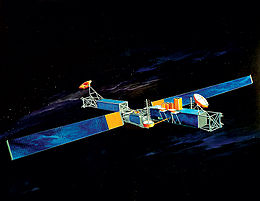Military Strategic and Tactical Relay satellite

Artist's impression of a Milstar Block I spacecraft
|
|
| Manufacturer |
Lockheed Martin (prime) TRW Boeing (formerly Hughes) |
|---|---|
| Country of origin | United States |
| Operator | U.S. Air Force |
| Applications | Military communications |
| Specifications | |
| Bus |
Milstar Block I Milstar Block II |
| Design life | 10 years |
| Launch mass | 4,500 kilograms (9,900 lb) |
| Regime | Geosynchronous |
| Production | |
| Status | Out of production Active |
| Built | 6 |
| Launched | 6 |
| Operational | 5 |
| Lost | 1 |
| First launch | USA-99, 1994-02-07 |
| Last launch | USA-169, 2003-04-08 |
Milstar, originally meaning Military Strategic and Tactical Relay, is a constellation of military communications satellites in geostationary orbit, which are operated by the United States Air Force, and provide secure and jam-resistant worldwide communications to meet the requirements of the Armed Forces of the United States. Six spacecraft were launched between 1994 and 2003, of which five are operational; the third launch failed, both damaging the satellite and leaving it in an unusable orbit.
Milstar Block I spacecraft, or Milstar Developmental Flight Satellite (DFS)-1 and -2, were designed with a Low Data Rate (LDR) payload in the +X wing of the satellite that broadcast in the Super High Frequency (SHF) and Extremely High Frequency (EHF) ranges, and also a classified communication payload in the -X wing. The DFS-1 satellite was launched on 7 February 1994 aboard the first Titan IV(401)A rocket, but with the classified -X wing payload deactivated. It was followed by the DFS-2 spacecraft on 7 November 1995. DFS-2 was similar to DFS-1, but the classified payload was replaced by ballast in the form of a precision machined aluminum block to maintain the weight and balance characteristics of the satellite. Both Block I satellites (USA-99 and USA-115) are still operational as of August 2016, over 20 years since they were launched.
The four later satellites were Block II spacecraft, which featured an additional medium data-rate payload. The first Block II satellite (DFS-3m, a hybrid mix of largely Block I support systems and LDR payload and a MDR (Medium Data Rate) Block II payload) was launched on 30 April 1999, using a Titan IV(401)B rocket. Due to a database error affecting the attitude control system of the Centaur upper stage of its carrier rocket, it was placed into a lower orbit than had been planned, and damaged by deployment at excessive rates. It could not be raised into its operational orbit due to fuel limitations. Its orbit was raised as much as possible to increase the expected lifetime and then it was permanently turned off after 10 days. It was the third consecutive, and last, failure of a Titan IV rocket. The remaining three satellites (DFS-4, -5, and -6) were launched on 27 February 2001, 15 January 2002, and 8 April 2003.
...
Wikipedia
